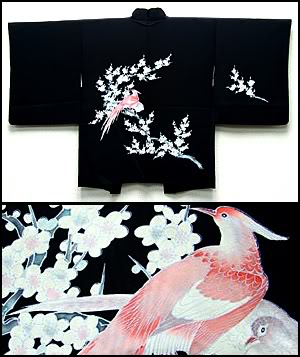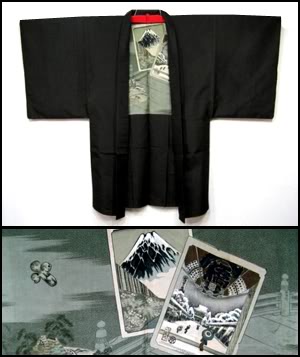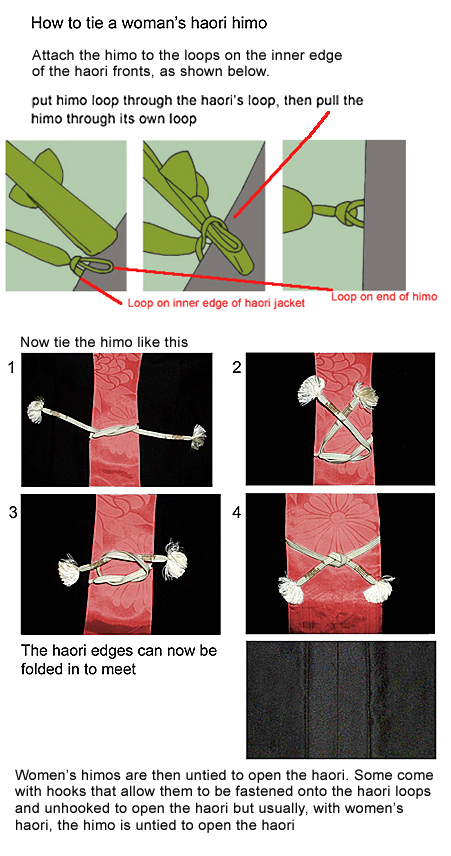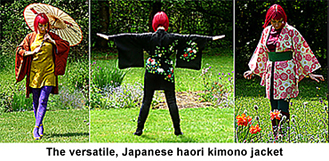wafuku – noun: traditional Japanese clothing
Welcome to my www.wafuku.co.uk WordPress blog
————————-
Japanese haori are long jackets, with deep, kimono style sleeves, designed to be worn on top of a kimono, though they are fabulous when worn over western world style clothes, like jeans or dresses. Women’s haori can be particularly beautiful, often with fabulous, Japanese textile art on them. They are not worn with an obi, though they do look great when cinched in with a belt or sash. They are usually fastened very loosely with a pair of ties called a himo, which is normally bought separately from the haori. Men’s himo are usually hooked onto the haori and unhooked to open it, rather than untied, though one can just untie the himo instead. Women’s himo are usually looped onto the haori and tied each time it is worn. Below you can see some examples of haori and, above those, instructions showing how to tie women’s himo, then how to tie men’s himo, as each gender ties theirs differently.
How to tie a woman’s haori himo
——————————
How to tie a man’s haori himo
——————————
Now some examples of women’s and men’s haori from my www.wafuku.co.uk website, where you can also see hundreds more
Women’s

1920s red haori
——————————
Geometric design haori, worn with a sash, with western world clothes
——————————
Lacy print haori
——————————

Fabulous bird design haori
——————————
All hand done shibori (intricate tie dye) haori
——————————

1920s purple haori
——————————

Butterflies galore haori
——————————

Pink haori with chrysanthemums
——————————
Examples of haori worn with western world clothing
Men’s haori
Men’s haori differ from women’s; the sleeves are attached to the body either all the way down the inner edge or all but an inch or so down. This is to match their kimonos. The sleeves of men’s kimonos are the same, whereas women’s kimono and haori sleeves swing loose and unattached at the body edge for a lot of their depth, this is because women wear very deep obis, so the sleeves have to be able to hang over them, whereas men wear much narrower obis and wear them lower down, so their sleeves do not get in the way and can be attached to the body of their garments all the way down.
Another difference with men’s kimonos and haoris is that they tend to be very subdued in pattern and colour. A long, long time back, the nobles and samurai got somewhat annoyed that so many rich merchants of lower class were able to afford and wear very ornate, ostentatious clothing, showing up the poorer of the samurai and upper classes and not allowing the richer ones to stand out, so a law was passed banning men who were neither samurai nor noblemen from wearing ornate clothing. This led the lower classes to adopt what was known as hidden beauty, putting fabulous textile designs on the linings of their haoris and on their naga-juban underwear kimonos. In time this made them feel superior and more classy, as their beautiful textiles were less flaunted but still there. You can see examples of that hidden beauty on the linings of some of the men’s haori below
3 geisha lining, men’s haori
——————————
Galloping horse lining, men’s haori
——————————

Airy ro silk men’s summer haori, with bamboo mon (crests)
——————————
Shunga (traditional Japanese erotic art) lining, men’s haori
——————————

Japanese woman lining, men’s haori
——————————

Beautiful scenes lining, men’s haori
——————————

Simi-e (ink and wash art) lining, men’s haori
——————————

Woman with scroll lining, men’s haori
——————————
Another shunga (traditional Japanese erotic art) lining, men’s haori
——————————

Fabulous scenery, on donsu lining, men’s haori.
Donsu linings have the design woven into the silk and haori with them are known as donpa haori
————————————
————————————











Would they have gotten in trouble because of the lining?
Not if it was not shown publicly. It had to be hidden in public.
Where might one purchase a new haori jacket – not a used vintage one?
Some of the haori on my website are unused, though I couldn’t say offhand which ones they are, it will be in the descriptions but there is no quick and easy way to pick out the few unused from the others. I have no idea where you would buy new ones outside of Japan.
I m a french fanatic of wafuku and i ve got a collection of 18 wonderful ancient silk men ahoris with incredible “hidden beauties”.
I bought them 25 years ago from a friend who lived in Kyoto and got them from her grandfather.
I bought silk hakamas too, and even a butsudan
But I don t have their himos, except for one of them.(hope to find some ?????)
I found your site this morning,and I am excited to read more!
I teach history of clothing in a fashion school and my students appreciate to discover these wonderful pieces of art,.
Thanks again for your culture, and the way you share it
Nicole Bednarek
I am so glad you like my blog and my wafuku.co.uk website. Japanese is not, however, my culture, I am Scottish and live in Scotland, it is just my passion. I am merely a collector of kimonos and other Japanese things, who has a great love and interest in all things Japanese.
My kimono collecting led me to buy way, way, way too many, which is why I became a seller of vintage kimonos and other wafuku and eventually started writing my blog.
Amazing info model is beautiful – loving the juxtaposition of traditional offset by the contemporary
Thank you for your comments. I am so glad you like the photos.
Although everyone knows what a Japanese kimono looks like, surpringly few have ever seen a haori or knew such a thing existed. I only learned of them about 12 years ago. Displaying them flat or on a hanger gives no idea of how they can look on. One can find photos online of them being worn over traditional kimono and obi but it is hard to imagine them with western world clothing, so I hoped my photos helped show that.
There are lots more such photos in this post… https://wafuku.wordpress.com/2010/06/07/haori-session-the-versatile-kimono-jackets-photo-shoot/
Hi. I’m new to haori silk jackets. I bought several from a vintage shop last week but I’m wondering how I can tell what they are really worth. Can you help me please?
Quite simply, they are worth what anyone is willing to pay for them.
There is no single value for haori or kimono.
Hello, what is the symbolistic meaning of himo tie ?
I really don’t know.
Who invented the Haori?
And what year was the Haori invented?
I am not aware of who invented the men’s haori or when it was first worn. I am not sure if it is known at all.
When it comes to women wearing them, the haori was originally worn by men only but women were allowed to wear them after the Meiji era and women’s ones became all the rage in Taisho era (1912-1926). Initially, I believe, it was geisha/geiko who started wearing men’s haori and anything they did tended to catch on and become fashionable among all women. They were the trend setters.
Thank you so much for your haori post. I received my very first one this week and was curious about what to do with the himo. Your information and examples are much appreciated!
I am very glad it was helpful.
Thanks for telling me.